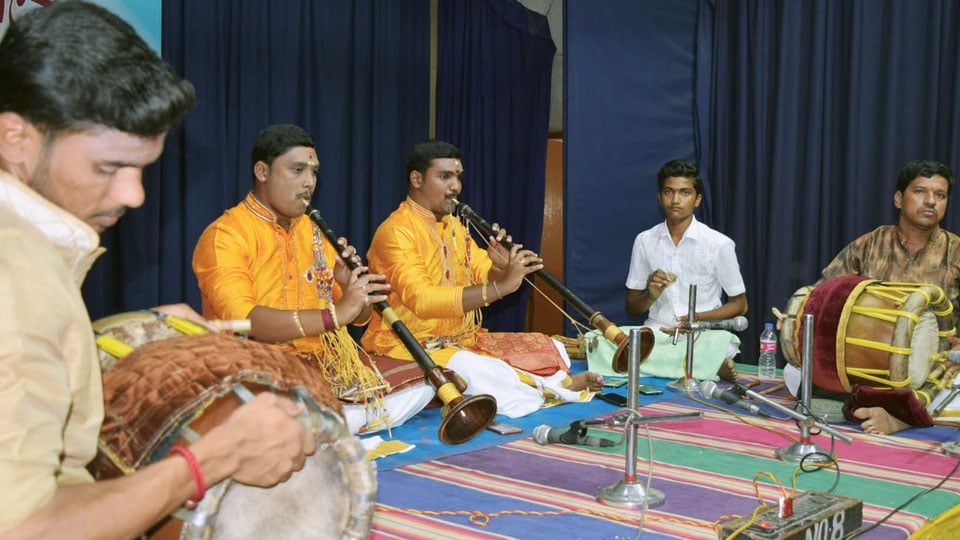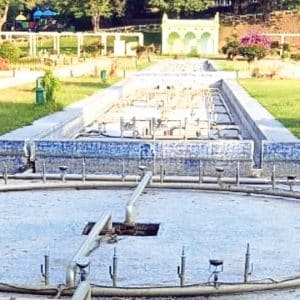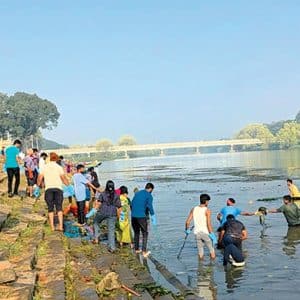By Dr. Padmavathi Narasimhan
Sri Nadabrahma Sangeetha Sabha, Mysuru, arranged two concerts of one-and-a-half hours each on the 28th last month. The first one was a nadaswaram concert by two brothers from Mysuru — Rajesh and Manju.
They were accompanied by Puneet and Madeva on Tavil and Shashank extended tala support to the concert. This concert and the next, a clarinet recital by Mohan, had two messages to convey — Instruments like Nadaswaram which are reduced to playing only for occasions like family weddings or at temples should be given a concert platform, wherein the artistes gratefully exhibit their talent and secondly, local artistes should be given opportunities by reputed local music organisations.
The very tone of Nadaswaram brings a feeling of jollity, auspiciousness and excitement. A traditional classical instrument, Nadaswaram is a double reed wind instrument played in the south part of India. Normally played in pairs, this auspicious instrument has a range of two and a half octaves.
Tiruvavadu durai Rajaratnam Pillai, Sheik Chinna Moulana and Bangalore Ramadasappa are some of the greatest nadaswaramists of South India.
The brothers offered many compositions in the allotted time — to mention a few, ‘Bhaja Manasa Vighneshwaram’ by Tullasivanam, a rarely heard kriti, ‘Padhavi nee’ in Salaga Bhairavi by Tyagaraja and ‘Ninne Nammitinayya’ by Mysore Vasudevachar in Simhendra Madhyama set to Mishra Chapu tala, which was taken as the main item of the evening.
The raga was detailed by the elder of the two and the composition was decorated with a neraval and swaras at the usual ‘Pannagendra Shayana’, wherein the younger artiste faltered a couple of times.
A mention must be made of the way in which this tala is to be indicated. The name ‘Chapu’ meaning stamping is derived from the post office wherein stamping is done with sound. And therefore it is meaningful to indicate this tala with the ‘Ghata’ for all the three times for the first, fourth and sixth beats. While it is common to see many musicians indicating this tala with the first beat with the palm upward, the brothers indicated this tala with the sixth beat upward, which is not permissible. A very energetic taniyavartanam followed by Puneet and Madeva.
‘Samanyavalla Shri Hariya seve’ in Charukeshi is a pleasing devaranama and it was good to see that the brothers prefixed it with a delightful alapana. The concert came to a close with Lalgudi Jayaraman’s tillana.
The second concert was by the well-known clarinet artiste of the city Mohan. He was accompanied by C.N. Tyagarajan on violin, Radhesha on mridanga and V.S. Ramesh on ghata.
It was heartening to see all top local artistes performing together on stage.

Mohan is seen presenting clarinet recital. He is accompanied by Radhesha on mridanga, V.S. Ramesh on ghata and C.N. Tyagarajan on violin.
Clarinet is a western instrument with a single reed mouthpiece and a good pitch range. While it is not easy to adapt a western instrument for Karnatak music, Mohan has successfully practiced this instrument with dedication and commitment producing pure classical music.
Mohan had chosen quite a few compositions for the concert. The opening number ‘Siddhi Vinayakam Anisham’ in Shanmukha Priya by Deekshitar offered obeisance to Lord Ganapati with swaras developed for the pallavi.
‘Nannu Brochutaku’ by Mysuru Vasudevachar in Shankarabharana is a composition rarely sung or played. The chitteswara shows the influence of western music on Acharya. Mohan and his team provided liveliness to the composition. ‘Appa rama Bhakti yento’ by Tyagaraja in Kamavardhini in Rupaka tala was a good contrast to the next main item in Hemavati.
The alapana of Hemavati was delivered with impressive phrases and brigas made for the instrument. Tyagarajan’s version of the raga was equally absorbing.
Another majestic composition of Deekshitar ‘Shreekantimatim Shankara Yuvatim’ in vilamba Adi was presented with the pace and refinement it requires. Mohan reached the Ati tara shadja note in this and the previous Alapanas. Shruti was atune and serene throughout the concert. Radhesha and Ramesh gave adequate support to the concert. Both these concerts concluded with a Lalgudi tillana.








Recent Comments